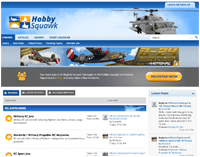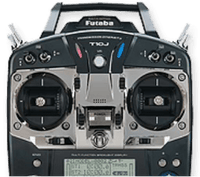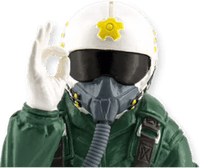How It’s Made: A Foam Electric PNP From Start to Finish
by Motion RCThis article originally appeared in the July 2019 edition of Model Aviation magazine and covers much of the non-proprietary information and processes in regards to the manufacturing of Freewing foam electric models. Authored by Motion RC Director of Global Products and Development Alpha Enos.
This is a wonderful time to be an RC modeler! As fellow hobbyists, we at Motion RC are as passionate about building, flying, and enjoying RC aircraft as you are. Strengthened by the support of our amazing global customer family these past seven years, we are grateful for the continued opportunity to move our beloved hobby forward. Our team is especially passionate about leading the development, distribution and support of RC airplanes you know and love. You may have seen several of our products reviewed here in Model Aviation and wondered what goes into creating them. Spanning a multi-year, multi-national development process, we’ve summarized the journey a foam electric RC airplane travels from our hands to your hangars. You may find these methods are generally applicable to the process of any RC foam manufacturer, with our personal touch. Let’s begin!
PLANNING

Customer feedback directly informs our planning sessions.
Our creative process begins with the planning phase. Customer feedback, comparative analysis, and market factors are all key considerations that influence our decision on which new model aircraft to create. We’ve developed over 50 aircraft over the years At any given time, our Motion RC development team is working on several models at different stages throughout this process in order to sustain the frequent stream of new products we are known for across a spectrum of sizes and price points. Once a subject aircraft is selected, its size, target cost and target market are set. We also use online forums, such as HobbySquawk.com, as direct points of interaction with our customer family to gauge potential interest. Our team balances making popular subjects like Corsairs and Cubs with less common subjects like Crusaders, MiGs, and Ta-152s, because we all have our wishlist of favorites!
DRAFTING AND PROTOTYPING

Every 3D model is created from scratch by our engineers.
With planning complete, we create 3D dimensional models from scratch using 3D CAD modeling software. Various references are used to hone the model’s exterior, including laser scanning and photogrammetric technology to transfer physical shapes to electronic models which can then be scaled and manipulated by our team of drafters. If available, we also access the full-size aircraft for “hands on” reference gathering. Modeling scale fidelity presents unique challenges in foam RC, but we believe that every reasonable effort should be made to represent the real aircraft with integrity. To us, these models embody history enlivened.
The exterior of an aircraft is only one aspect of the 3D drafting phase. The most important elements we focus on involve the layout of various electronics and structural components that will enable the aircraft to fly, and the aerodynamic optimizations that will ensure it flies well. Computer simulations help us assess the efficacy of proposed airfoils, proportions, material thicknesses, battery position and general construction of major components. We also draw upon previous models in our database, leveraging lessons and customer feedback as to which characteristics they prefer. Whether a warbird or EDF jet, extra attention is spent on balancing undercarriage loads. Ideal wing loading is also crucial, so each sub-assembly is designed in harmony with the others to balance the final model aircraft’s landing speed, weight, transportability, structural integrity, and component cost. After a complete aircraft is drafted, we proceed to the prototyping phase where the flying begins!
Due to the exceedingly high cost of the final production molds, during the prototyping stage, we fly prototypes CNC milled from solid foam. This enables our team to fly the prototype aircraft and make cost-effective adjustments as needed to test different wings or parts before investing in the final molds. Prototypes are flown a minimum of 200 times over several months to satisfy the hundreds of safety and performance criteria our test program requires. Proprietary tools and methods are applied to optimize the aircraft aerodynamically to achieve its desired flight behavior. Trainers are designed to have a gentle stall, advanced aircraft are tuned to provide high performance with reasonable flight times, and aircraft intended to attract a general audience are balanced with a range of pilot-friendly characteristics.
Once the prototype’s aesthetic and aerodynamic elements are finalized, our mold design team converts the prototype’s files to create the actual molds. This conversion is a very labor-intensive process which can take two to four months, involving scientific methods to visualize how the molds will perform during both the injection and assembly phases. The major parts themselves are divided into sub-structures, which are assembled like a puzzle. It is our mold designer’s challenge to fit those puzzle pieces into a mold without sacrificing mold performance. A 90mm EDF jet’s fuselage might include twenty different interlocking foam structures, so their constituent shapes are very different from what a pilot will observe from the outside on the finished product. Innovations within this mold design phase have contributed to the smooth surface quality seen on many modern foam RC aircraft.
A common misconception about “foam planes” is that they are entirely foam. In fact, one of our typical midsize aircraft will utilize parts composed of many materials including foam, fiberglass, carbon fiber, plastic, FRP, HDPE, plywood, brass, nylon, steel, and aluminum. For example, just the wing alone of our Freewing 80mm A-10 Thunderbolt is comprised of five interlocking foam parts and three plastic parts all requiring molds, seven laser cut plywood parts, a CNC’d aluminum bracer, four carbon fiber parts, LEDs, a circuit board, and associated hardware, including nylon, brass, and steel components. Even the foam shell that encases the model’s parts inside the shipping box is meticulously designed to be compact yet secure. A finished model like the Freewing A-10 contains over 800 parts. Coupled with an extensive supply chain and material/tooling costs, the development costs of a humble RC model aircraft of this type surpass six figures!

A 5-ton CNC machine mills a fuselage mold over several days.
MOLD MAKING
Our molds are milled or “carved” from solid steel by giant CNC machines, then workers finish the molds with hand polishing and rigging. The process of milling the molds alone requires hundreds of hours. Larger fuselage and wing molds can weigh several hundred pounds and are transported using forklifts, and even smaller plastic molds require a heavy duty gantry to move them into the injection machines. ISO9001 standards are maintained at all our partner factories to ensure quality, and our Motion RC team personally inspects each factory at regular intervals. Molds constitute such a large investment in our company’s future, as a mold can last many years when maintained properly. Once finished, the set of molds are transported to our factories to begin their work.
The foam molds are comprised of two halves which are designed to fit together. Liquid foam is injected at a predetermined temperature and pressure into the cavities between the two mold halves. After a set time, the mold halves are hydraulically separated, and a worker enters the machine to remove each part by hand before preparing the mold to cycle again. Much like a recipe, the ingredients are tested until the perfect combination is found. Each aircraft’s constituent puzzle pieces are different, and so our techniques behind designing molds that perform well with optimal surface smoothness, flow, and consistency for a given volume is a carefully applied science. Most modern foam planes use EPO foam, which is more dense and “oily” than EPS foam, which is lighter but less resistant to damage. There are also different grades of EPO foam, each with different properties. Sometimes a single aircraft will use two or even three grades of foam. For example, our Freewing A-10 uses heavier but stronger foam for its wing roots, and lighter foam for its fuselage where flight loads are comparatively lower.
PRODUCTION

Assembling a Freewing A-10’s internal wing structure, later encased in foam.
With the molds completed and tested, the final production phase can begin. First, production teams are trained to produce the new aircraft, with direct input from the engineering team to ensure every detail is reviewed carefully. Materials are ordered from a series of suppliers, initial production testing begins, and flight testing continues. This process can take several months before we at Motion RC give the final “green light” to begin serial production, which will mass-produce the final model aircraft our customers will receive around the world.
Serial production begins with preparing the molded foam and molded plastic parts, painting all external parts, then constructing, installing, and testing the electronics including servos, ESCs, motors, electric retracts, and LED lighting. Independent QC teams scrutinize each stage, with specialists in electronics, molding, painting chemistry, and packaging. To protect the foam surface, every workstation is padded, and each time a foam part is moved to the next station it is rewrapped in foam and transitted on a foam padded rolling shelf. Workstations are rewrapped in fresh foam on a regular basis to keep them clean. Over 100 people will touch an aircraft through the production process before it reaches a customer, so protective measures are important. At any point in the production line, damaged parts are identified and scrapped.
Painting a foam electric model is an art form unto itself and requires creating copper paint molds or masks, which conform to the surface of the foam model to block paint from adhering to unwanted areas. Each reusable copper mask is created by machine and finished by hand, and even includes every panel line to prevent overspray. The 1mm wide panel lines are hammered into the copper to create a raised relief. Artisans who specialize in this technique are rare, and we keep them very busy! In certain examples such as our Me-262, “mottling” camouflage is airbrushed by hand. Special paint formulated for foam is used to strengthen adhesion and aid wear resistance.

Inspecting F-16 canopies before packaging.
At the primary assembly factory, different teams focus on different aspects of production. There are 24 different teams, from painters to decalers to testers to packagers. In a given month, these teams will produce varying quantities of an average of twenty different aircraft models to satisfy our orders. Due to the handcrafted nature of creating foam RC aircraft, training and retaining an experienced workforce is an important facet of establishing a consistent product. We’re proud of our entire team, who each work very hard and pour their talents into creating your aircraft!
FROM OUR HANGAR TO YOURS
After our initial order for an aircraft and its spare parts is mass-produced, it is packaged and shipped to our distribution centers in the US and Europe, where it awaits its final destination: your home. Meanwhile, our Motion RC marketing team generates exciting content, our technical support teams go to work delivering world-class support of our newest creation, and our development team continues with the next prototype in our product pipeline.
As you can see, the journey of a foam RC model aircraft from its inception in our office to its first safe landing at your local flying field is a long one. It is the culmination of nearly two years of planning, development, and production. Most importantly, we believe it is just the beginning because more vital than the creation of an RC aircraft is our dutiful support of it. This RC hobby is greater than all of us, and we each have a special role to play in its proliferation. If our team’s creative process has piqued your interest, we hope it inspires you to share this hobby with a friend. As for Motion RC, our work continues in support of all flyers everywhere!
Get the latest from Motion RC sale and product announcements
You can unsubscribe at any time!

Hobby Squawk Community Forum
visit forum
RC Knowledge Blog
visit blog
Guidance & advice for beginners
Find out more- Choosing a selection results in a full page refresh.
- Press the space key then arrow keys to make a selection.
